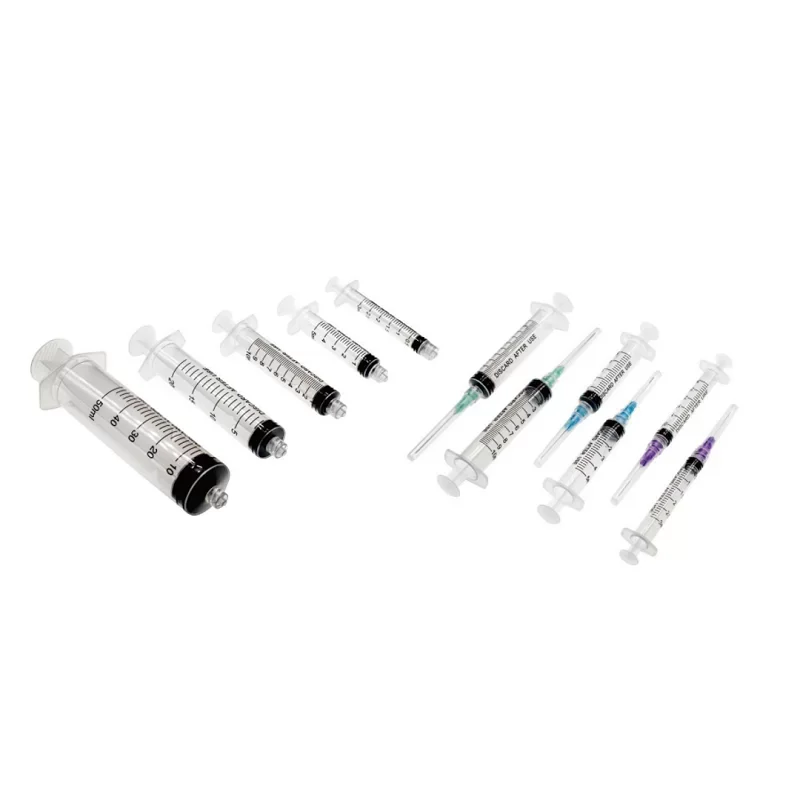Syringes are not only available in various types, but also in a wide range of uses. Today, CMC Medical will share with you the structural specifications and injection routes of medical disposable syringes.
The structure of the disposable syringe includes a nipple, an empty barrel, a piston, a piston shaft, and a piston rod (10-1), and the specifications are 1, 2, 5, 10, 20, 30, and 50, with a total volume of 100 ml.
Needle structure, specification
The needle is composed of three parts: the needle tip, the needle pedicle, and the pintle. Its commonly used models are 4.5, 5, 5.5, 6, 6.5, 7, 8, 9 and so on.
Specifications and uses of various syringes and needles
Subcutaneous injection 1ml 4.5~5
Intramuscular injection 2.5ml 5.5~6
Intravenous injection, venous blood collection 2.5ml 10ml 6.5~7 5 10 20 50ml 6, 7, 8, 9
The thickness of the needle is represented by several numbers, generally 4.5, 5, 6, 7, etc.
No. 7 is a needle diameter of 0.7mm (probably the outer diameter)
Generally, children use size 4.5 or 5. Size 7 for adults.

Injection routes for single-use syringes
1. Intradermal injection
The amount of intradermal injection is small, mostly 0.01 ml, and is often used in allergy tests (including tetanus toxoid, antibiotics and other drugs, serum, etc.), vaccination (such as BCG, etc.) and local anesthesia. Due to the dense dermis, nerve endings Many, the absorption of anesthetics is slow, so local anesthesia starts with intradermal injection of local orange peel rash, and then subcutaneous injection to relieve pain. The intradermal test generally selects the volar side of the forearm, but the BCG vaccination is injected intradermally in the middle of the deltoid muscle of the left upper arm.
2. Subcutaneous injection
Subcutaneous injection is to inject drugs into the subcutaneous tissue, which is loose, rich in nerves, blood vessels and lymph fluid, and is easy to absorb, but there is pain during injection. It is therefore commonly used in vaccinations, local anesthesia, and certain medications such as epinephrine. Usually choose the lower edge of the deltoid muscle on the outer side of the upper arm, the lower edge of the scapula or the abdomen (rabies vaccine), and the outer thigh.
3. Intramuscular injection
Intramuscular injection is also called intramuscular injection. Widely used to push various stimulating drugs. Muscle blood vessels are particularly abundant, and drug absorption is fast. The injection site is mostly used for the deltoid muscle, gluteus maximus, gluteus medius, gluteus minimus, vastus lateralis, etc., and a needle of 2.5~3cm is usually injected. The glutes are the most commonly used.
4. Intravenous injection
Intravenous injections are given by slowly injecting the drug into a vein with a syringe over 20-30 minutes. It is often used in emergency patients to achieve rapid therapeutic effect. The general dose is above 10ml, and irritating drugs need to take effect quickly, and animal serum products (such as tetanus antitoxin) can be injected intravenously, and the injection sites are mostly the median vein (elbow), saphenous vein (inner thigh), jugular vein and scalp Vein (mostly used in children), etc. .
5. In vivo injection
Intracorporeal injection is the use of a syringe to inject drugs into various body cavities for treatment. Commonly used are intraventricular injection, intrathecal injection, intrathoracic injection, artificial pneumothorax, tuberculosis pneumoperitoneum, intraperitoneal injection, intra-articular injection, etc.

Medical Disposable Syringes Supplier - CMC Medical
CMC Medical Tech Co., Ltd. was established in 2010 and is located in Nanjing City, Jiangsu Province. CMC is committed to providing customers with a complete set of medical consumable parts supply system and complete pharmaceutical packaging solutions. Welcome to consult us!
https://www.medi-cmc.com/Disposable-medical-syringes-specifications-and-injection-routes.html














Comments (0)